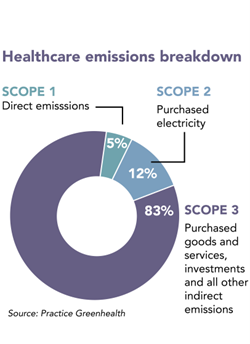The healthcare sector faces an age-old paradox: it’s significantly impacted by the climate crisis and simultaneously contributes to it. Extreme weather, worsening air quality, heat waves, and other climate impacts lead to more illnesses to treat, yet the healthcare industry is responsible for nearly 10% of U.S. greenhouse gas emissions.
In response to this pressing challenge, over 100 hospitals and health systems have pledged to cut emissions in half by 2030 and reach net-zero by 2050. But how can the healthcare industry deliver on this vision?
The answer lies in tapping into the wealth of hospital data to uncover waste-reduction opportunities and make “greener” supply chain decisions. Keep reading for the full scoop on how hospitals can use data to make a significant climate impact.
Reducing waste in patient care
Advanced data analytics can help hospitals predict patient needs more precisely and reduce overutilization of treatments, tests, and services. For instance, studies show that using predictive data techniques can lead to a nearly 20% reduction in hospital readmissions and length of stay. Shockingly, the estimated total annual cost of waste in healthcare is a staggering $800 billion. Using data to identify areas of wasted care not only can help hospitals save money, but also cut environment-damaging emissions.
Data can also pinpoint hotspots for resource waste. For example, operating rooms alone generate up to 70% of emissions in some hospitals and generate “three to six times as much carbon as the rest of health systems.” Hospitals can use analytics to identify which departments contribute to their biggest sources of emissions and take strategic action to reduce them.
Building green supply chains
The vast majority of emissions stemming from healthcare arise not from direct operations, but from upstream due to purchased medical goods and supplies. According to Practice GreenHealth, 83% of hospital emissions are caused by purchased goods and services.
Yet data-enabled inventory optimization can squeeze out waste across global supply chains. Using an enterprise analytics solution to refine inventory management, purchasing, and logistics, hospitals can identify areas to “green” the supply chain.
For example, by better understanding their inventory, hospitals can reduce over-purchasing and identify opportunities to purchase more sustainable products. Incorporating sustainability metrics into procurement choices can encourage the adoption of climate-friendly products and practices over the long term.
Accelerating preventative health to decarbonize care
Population health analytics can enable providers to better target screening programs, chronic disease management, and education to bend the curve on disease rates. In turn, keeping populations healthier longer avoids environmentally burdensome acute care surgeries or procedures down the line.
Preventative health efforts can greatly reduce resource-intensive doctor visits, emergency care, and the use of medical supplies. For instance, studies show that surgeries account for 20-33% of hospital waste—whereas preventative care, such as physical therapy, generates almost none. Focusing on sustainably keeping populations healthier for longer is a winning proposition for both human health and the planet.
Letting data light the path to healthcare sustainability
In the end, realizing greener care requires having the numbers to back decisions. Whether it is through reducing superfluous treatments, making supply chain purchasing more eco-friendly, or minimizing resource-intensive care, hospitals can use their data to make strategic sustainability gains.
Although tackling climate change in healthcare won’t be easy, using data to guide decisions can set the industry on track to cut emissions in a much-needed way. As healthcare finds opportunities to reduce waste, it will benefit both the environment and public health.
- Why We’re Best in KLAS—Again! - February 7, 2024
- Building a Greener Healthcare System with Data Analytics - January 22, 2024
- Hospital Finance Predictions for 2024 - January 8, 2024






